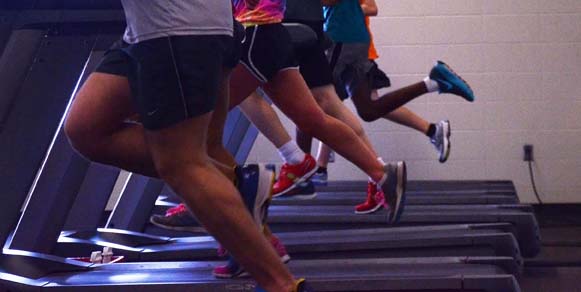Sports move indoors
February 7, 2014
During the long winter months, sports are driven indoors both in-season and off-season. The offseason sports during the winter time have to alter their training method in order to still improve their overall fitness and be ready for when their season comes around.
Soccer is one sport that is affected largely by the move indoors, but boys soccer coach Heath Weeks looks at this as a time to improve on the little things. Currently, the team has an open gym time in the mornings a few days a week to divide up and play a few smaller games. Even though there is a lack of space to move around in when playing in an area about the size of a basketball court, Weeks finds a few positives.
“Players get more comfortable in smaller spaces,” Weeks said.
He finds that when players are restricted into smaller areas with many people, it can improve their foot skills and prepare them for the transition outdoors, making them more spatially aware of their surroundings and more comfortable if in a similar situation.
Another positive Weeks finds about practicing inside is that practices can be spent focusing on improving the athletes’ strength and conditioning. Due to the different playing conditions indoors such as the wood floor, which makes the ball roll faster, adjustments are made to better mimic an outdoor playing area. One adjustment is the use of a different ball that is slightly smaller and weighted to slow down the pace to make it similar to an outdoor game.
Aside from the challenges faced when practicing indoors, Weeks thinks it is a great time for the team to become stronger. Due to the close proximity to other players when inside, player communication tends to increase, which Weeks hopes can reinforce the idea of teamwork and getting to know the new players.
The largest obstacle faced when training indoors according to Weeks would be the limited amount of space. Head girls track coach Chris Siewert would also agree that the limited amount of space indoors is the largest hurdle when track athletes are pushed inside due to the weather.
“When we are inside, we try to mimic an outdoor workout as best as we can,” Siewert said.
Indoor track workouts are focused on strength and conditioning ranging from treadmill workouts, hallway running, strength circuits or P90X on somedays.
Junior cross country and track athlete Jordyn Kleve prefers to run outdoors but when the weather is in the single digits or if it is freezing cold wind, she finds it more beneficial to run inside.
“Treadmill is the only option for me, wouldn’t say it’s the most fun thing to do, but you get in a run,” Kleve said.
To try to stay entertained while on the treadmill, Kleve enjoys watching movies while at home or focusing on her form to get her mind off of the treadmill, like she is actually running outside.
Treadmill workouts are not always the best option for the track team because there are a limited number of treadmills available, but the team makes do by doing interval workouts by splitting the time on the treadmill with another athlete running laps around the school and switching.
Some athletes have trouble with running on the treadmill or through the hallways due to common injuries like shin splints. When training indoors and running on a constantly flat and hard surface, the little muscles in the foot and ankle area are not worked as much as with the natural terrain outdoors.
“To prevent shin splints, we try to run indoors in moderation,” Siewert said. Each athlete’s tolerance to the cement floors varries.
One benefit of the time spent indoors is that it serves as a starting place for athletes new to the sport. Being indoors and in a confinded space can also make communication among coaches and athletes easier because when the team is outdoors, everyone becomes so far spread apart.
“When you are split up into small groups inside, you get to know your athletes,” Siewert said.
Siewert also enjoys being able to keep the athletes safe when indoors, escpecially those who are not used to being outside in the cold.
“Being outside without proper clothing is not fun and is hard on the body, ” Siewert said. “Unless you are used to it like a distance kid who has been running outside all winter, other athletes you can’t really throw outside in the snow, you can’t sprint as fast on an icy track, can’t jump in a high jump pit that’s got snow and ice in it.”
Staying inside serves as the safe alternative to the sometimes brutal weather conditions of the midwest for all sports and athletes.





